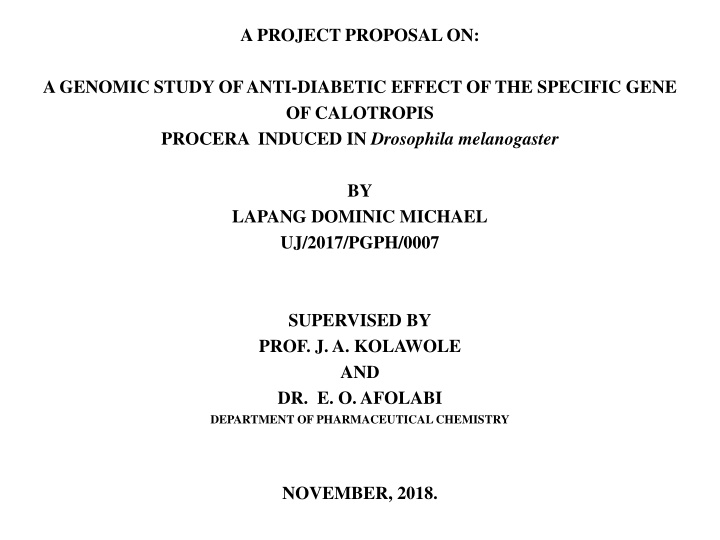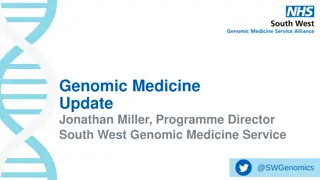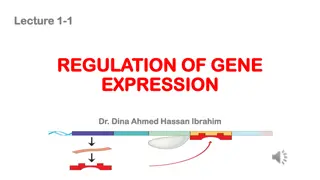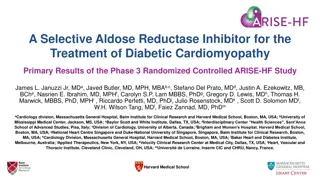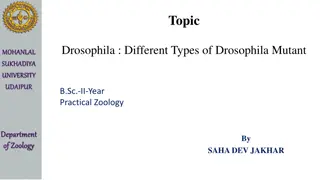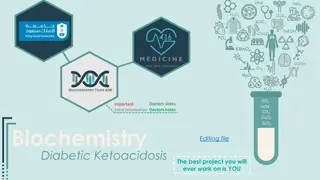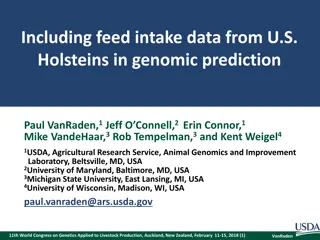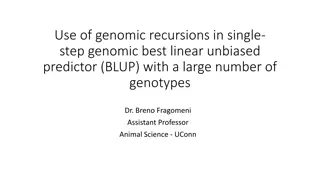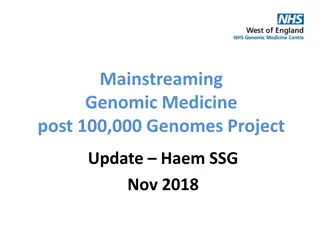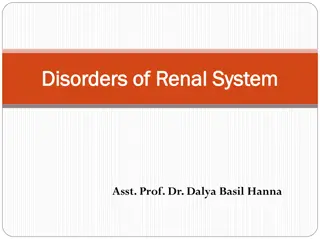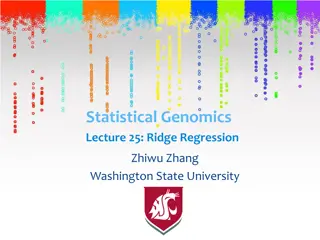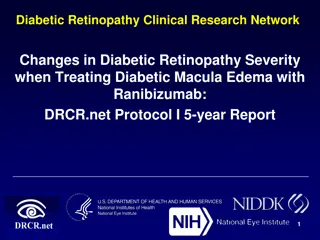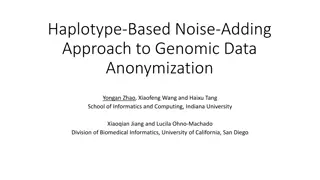Genomic Study of Anti-Diabetic Effect of Calotropis Procera Gene in Drosophila
Diabetes mellitus is a prevalent metabolic disorder with severe consequences worldwide. This project aims to investigate the potential anti-diabetic properties of the specific gene from Calotropis procera in Drosophila melanogaster, with the goal of identifying active metabolites, evaluating gene effects, and contributing to the understanding of alternative treatments for diabetes.
Download Presentation

Please find below an Image/Link to download the presentation.
The content on the website is provided AS IS for your information and personal use only. It may not be sold, licensed, or shared on other websites without obtaining consent from the author.If you encounter any issues during the download, it is possible that the publisher has removed the file from their server.
You are allowed to download the files provided on this website for personal or commercial use, subject to the condition that they are used lawfully. All files are the property of their respective owners.
The content on the website is provided AS IS for your information and personal use only. It may not be sold, licensed, or shared on other websites without obtaining consent from the author.
E N D
Presentation Transcript
A PROJECT PROPOSAL ON: A GENOMIC STUDY OF ANTI-DIABETIC EFFECT OF THE SPECIFIC GENE OF CALOTROPIS PROCERA INDUCED IN Drosophila melanogaster BY LAPANG DOMINIC MICHAEL UJ/2017/PGPH/0007 SUPERVISED BY PROF. J. A. KOLAWOLE AND DR. E. O. AFOLABI DEPARTMENT OF PHARMACEUTICAL CHEMISTRY NOVEMBER, 2018.
Background Diabetes hyperglycemia caused by a relative or absolute deficiency of insulin or by resistance to the action of insulin at the cellular level,(fasanmade et al.,2008). mellitus is a metabolism disorder characterized by inappropriate It is the most common endocrine disorder, affecting as many as million population worldwide, (Brown et al., (2003) The clinical consequence of the syndrome include ,blindness, heart and blood vessel disease, stroke, kidney failure, amputation and nerve damage. According to world health organization (2006), at least 171 million people worldwide suffer from diabetes and it is more prevalent in develop countries.
Background contd The increase in incident of diabetes in developing countries follows the trends of urbanization and lifestyle changes most importantly western style diet (world health organization 2006). Disturbances occur in production and action of insulin, by a hormones secreted by the islet of langerhans in the pancrease which is implicated in the disease (shafer, 2000). In addition to insulin, aging, over weight and several other hormones affect blood glucose level there by preventing glucose from entering the cells leeding to hyperglycemia which may result in acute and chronic complication such as diabetic keto-acidosis, coronary artery disease, cerebrovascular disease etc.
RESEARCH QUESTION The questions that readily come to mind are: Is it possible to find active metabolites present in Calotropis procera that exibit anti-diabetic effect? Is it possible for a gene of Calotropis procera to have anti- diabetic effect? should the evaluation of a specific gene of the research plant on drosophila give a significant result?
Aim of the study To carry out a genomic study of anti-diabetic effect of the specific gene of Calotropis procera in Drosophila melanogaster Specific Objectives: To identify the active metabolites present in the sample (extract). To identify the specific gene of Calotropis procera with anti-diabetic effect. To evaluate the gene effect (significant) on Drosophila melanogaster.
Problem Statement Presently, no satisfactory or effective treatment that is available to cure diabetes mellitus. Although synthetic drugs are used, there are several drawbacks (Jana et al., 2015). The attributed antihyperglycemic effects of many traditional plants are due to their ability for the management of diabetes mellitus Furthermore, the lack of considerable toxicity associated with the plant makes it a choice for further drug discovery. Although the antihyperglycemic potentiality of Calotropis procera has been reported previously by some journals (Ajiboso et al., 2016), but its molecular mechanism has not yet been described clearly. Data on the antidiabetic activity study of this plant part on molecular level are scanty. Hence, this study is conducted to explore these lapses and fill in the knowledge gap.
JUSTIFICATION Currently, there are several drugs available for treatment of diabetes mellitus but most of them are synthetic drugs and this makes the anti- diabetic treatment costly. In view of reducing the cost of treatment for diabetes mellitus, there is considerable research for herbal production as anti-diabetics and around 12,000 plants have been reported to possess antidiabetic property. There are claims on the use of Calotropis procera leaves by folklore tradition of Nigeria in management of several ailments, including diabetes. Hence, this research aims to carry out a genomic study of anti-diabetic effect of the specific gene of Calotropis procera induced in Drosophila melanogaster
MATERIAL AND METHOD Collection of Plant Material The plant material will be collected from Rantya Gyel, Jos south Local Government Area Plateau State. The plant will be authenticated and identified at the African Centre of Excellence in phytomedicine Research and Development, University of Jos, Nigeria.
Plant extract preparation The plant materials will be shade dried at room temperature for 10 days, afterwards the dried leaves will be grinded to a powdered form with the help of a hand grinding mill, and the powder will be passed through sieve. About 750 g of the powdered leaf will be added to a container with 1,500 ml methanol and allowed to stand for 8 days with occasional swirling and shaking. The content will then be evaporated using rotator evaporator for a solid leaf extract.
https://upload.wikimedia.org/wikipedia/commons/thumb/3/31/Swallowwort.jpg/220px-Swallowwort.jpghttps://upload.wikimedia.org/wikipedia/commons/thumb/3/31/Swallowwort.jpg/220px-Swallowwort.jpg Plate 1:Calotropis procera plant https://en.m.wikipedia.org/wiki/calotropis procera
Phytochemical Screening The preliminary phytochemical analysis of the extracts will be carry out to determine the presence of tannins, flavonoids, saponins, alkaloids, phenols and glycosides using standard procedures (Kasolo et al.,2010).
MOLECULAR STUDIES Polymerase Chain Reaction (PCR) also called as Molecular Photo typing means a technique used to amplify small and targeted segments of DNA to produce millons of copies of a specific gene fragment. This technique was developed in 1983 by Kary Mullis, he was awarded Nobel prize in 1993 for his work in PCR along with Michael (Tahminur et al., 2013).
Essential Components of PCR The following are the essential components of PCR Themal cyclers (thermocyclers) Target DNA (DNA template) Two primers(forward and reverse primers) Taq polymerase (themus aquaticus) Buffers Deoxy nucleotide triphosphates (d NTP s) Monovalent \bivalent cation Nucleotides (A\T\G\C) Water
Process Involved In PCR There are 3 main process namely Denaturation Annealing Elongation\ extension. Primer Sequence (5 TCTTTGCAGGTCAAGGCTCT 3 ) > Forward primers (5 ATTTGCTCCCACGATGAAAC 3 ) > Reverse primers (Addapted by Akhtar et al., 2014)
Agarose Gel Electrophoresis Agarose gel consists of 0.9% agarose in 40mM tris-base pH-8.3, 20mM acetic acid, 1mM purified from 0.9% agarose gels using QIA(quick gel extraction kit). After gel electrophoresis technique, gel is soaked in a buffer containing a specific stains DNA (Lilit Gariyan and Nidhi Avashia., 2013). After the completion of all of the 3 process, it is visualized by UV trans-illumination. If the bands are present, it indicates the target sequence of original DNA sample and absence of any bands indicates the absence of original DNA sample.
Sequencing/ ingredients for sequencing DNA template to be sequence. DNA primers DNA polymerase enzymes. The four DNA nucleotides (dATP, dTTP, dCTP, and dGTP). After sequencing, then BLAST.
The Evaluation of the Efficiency of the Leaf Extract on Drosophila melanogaster. Drosophila Melanogaster (fruit fly) will be obtained from the fly laboratory of African Center for Excellence in Phytomedicine Research and Development, University of Jos, Nigeria, where the animals will be kept for the period of the study.
Collection and sample preparation On day 10, flies will be anesthetized using CO2, separated by sex, and deposited in groups of 4 or 5 into pre-weighed eppendorf tubes. After mass will be recorded, samples will be labeled and stored at 80OC until further processing could take place. Samples will be flash-frozen and then vortexed to remove heads from bodies and heads discarded. This is done because eye pigment may interfere with absorption readings. To finish preparing samples for spectro-photometric analysis of sugars, the metabolites must first be liberated from the fly body into a protective buffer solution.
collection and sample preparation cont.d Buffer A will be added to the bodies in the quantity of 100uL buffer per fly body. Samples will then be ground-up and separated by centrifuging. The supernatant is the completed sample and will be examined using the appropriate Sigma assay kit and enzymes. Buffer A is often used in the laboratory for general purposes and so contains a number of compounds designed to protect proteins from degradation as well as reducing agents. The composition of buffer A is identical to that of the buffer used in previous laboratory metabolic studies (Marris et al.,2012).
Experimental design A total of 200 Drosophila will be randomly grouped into four (4) groups as follows: Group 1: sucrose- induced diabetic Drosophila administered treated with mixed feed. Group 2: Negative control group fed with normal Drosophila feed. Group 3: Positive control group fed with normal diabetic drug (metformin). Group4: Diabetic treated with Calotropis procera gene.(Adopted by Ahmed et al.,2016)
Data Analysis All experiment will be carried out in triplicate and data obtain from the study will be subjected to one way analysis of variance (ANOVA). The treatment mean will be compared using F-ratio at 5% or 1% level of significant.
Expected Result A comparison of the glucose levels from four different groups will be studied. Sucrose induce diabetic Drosophila should significantly elevated the blood glucose levels after four days and above compared with the (control group). In the diabetic Drosophila model, the extracts will show significant hypoglycemic effect and the effect of the administered extract is dose dependant
Expected Result Cont.d It is expected that the lower dose (100 mg/kg) of the C.procera only produced a statistical significant effect less than the higher dose (150 mg/kg), after its administration. The data obtained from this study will be the first documented data demonstrated the appropriate doses that can be traditionally used for treating diabetic people. In addition, the result should not show any toxicity and mortality occur to the control group.
SELECTED REFERENCES Akhtar S, Shahid AA, Rao AQ, Bajwa KS, Muzaffar A, Lateef A, Husnain T. (2014). Genetic effects of Calotropis procera CpTIP1 gene on fiber quality in cotton (Gossypium hirsutum). Adv. life sci., 1(4) pp. 223-230. Fasanmade, O.A., Odeniyi, I.A. and Ogbera, A.O. (2008). Diabetic Ketoacidosis: diagnosis and treatment effects on cognition in schizophrenia. Schizophr. Bulletin. 31:888 894. Brown, A.F., Mangione, C.M., Saliba, D. and Sarkisian, C.A. (2003). Guidelines for improving the care of the older person with diabetes mellitus. Journal of American Sociaty, 5:5265-80. Cariello, A. and Motz, E. (2004). Is oxidative stress the pathogenic mechanism underlying insulin resistance, diabetes and cardio vascular diseases? The common soil hypothesis revisited. Arterioscler. Throm. Vasc. Biol. 24:816- 23.
Leonard, G., Adamu, O., Edeghagba, B., Omolara, M.A., Aniekpeno, I.E. and Ezeokoli, O.T. (2013). Antimicrobialactivity of extracts of Jatropha curcas and Calotropis procera leaves against pathogenic isolates from motorcycle helmets in Lagos metropolis. Microbiology. Applied Science; 2(12): 292-302. International Journal of Current. Kasolo, J.N., Bimenya, G.S., Ojok, L., Ochieng, J., Ogwal-Okeng, J.W. (2010) Phytochemicals and uses of oleifera leaves in Ugandan rural communities. Journal of Medicinal Plant Research.;4 (9):753-757. Tahminur, M.D., Muhammed, S., Razia, S., Arumina, M. and Muntahina S. (2013) Polymerase Chain Reaction-A Short Review,4(1):30-36. Lili, G. and Nidhi, A. (2013). Research Techniques made simple-PCR;Journal of Invest Dermatol. thiobarturic acid reaction. Journal of Biochemistry. 75:351- 358.
THANK YOU FOR LISTENING
